This post may contain affiliate links. See my disclosure policy.
This gumbo recipe is the perfect combination of Cajun spices mixed with juicy chicken, Andouille sausage, and fresh seafood swimming in a flavorful roux-based broth and served with a side of rice. So comforting and delicious, enjoy this classic New Orleans meal any time of year.
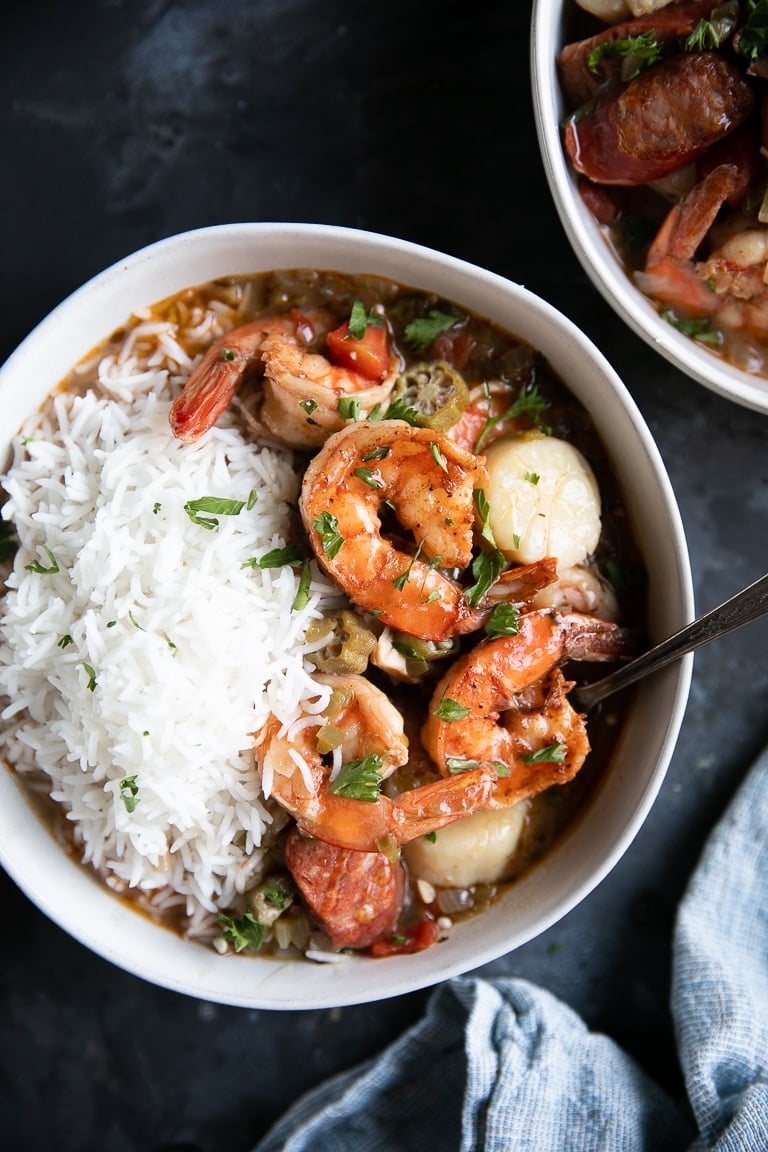
Packed full of hearty and well-seasoned ingredients, this gumbo is one of my very favorite recipes (right up there with my Jambalaya). In this version, you’ll find all the essentials – seafood, chicken, and spicy Andouille sausage – to make the very best gumbo recipe ever.
Before getting started…
Gumbo takes approximately 2-3 hours to make, start to finish, and isn’t really a recipe that should be made if you are in a hurry. It is a million times worth the time and energy but does take some time to come together.
Fortunately, this recipe makes a lot – enough to feed a small party or your family for several days.
Table of contents
What is Gumbo?
The exact origin of what we have come to know as gumbo is somewhat debated, but it is often used as a metaphor for the melting pot of cultures that have come to exist in southern Louisiana. A perfect combination of French, Spanish, indigenous tribes, African, Italian, and German culinary influence, it is known that people from each of these cultures lived together in a small area in the 18th and 19th centuries.
In fact, gumbo gets its name from the word ki ngombo, or simply gombo; the word for okra in several West African languages.
Regardless of its official origin, Gumbo remains the official state dish of Louisiana. Although there are several variations of this popular stew, nearly all gumbo recipes are made with the same key elements: a stock, meat or shellfish (or both), a thickener (roux, filé powder, or okra), and the “Cajun Holy Trinity”.
What’s in Gumbo?
Gumbo is a savory stew consisting of a roux made from all-purpose flour cooked with a fat (butter, lard, bacon grease), meat (chicken and/or sausage), seafood (shrimp, crawfish, crab, sea scallops), various seasonings (paprika, Cajun seasoning, sugar, bay leaves, dried thyme), garlic, vegetables (onions, celery, bell peppers, tomatoes, okra), chicken stock, white vinegar, hot sauce, and filé powder.

Gumbo Roux
Making roux really isn’t that hard. If this is your first time, read the steps, be attentive, have patience, and you’ll be good.
What is Roux?
A Roux is made by cooking together flour with a fat (lard, butter, oil) and is used to thicken or flavor sauces, soup, and stew. Typically made from equal parts flour and fat and cooked to varying shades of doneness depending on if the sauce will be used to thicken or flavor a dish. Compared to étouffée, which uses a roux to both flavor and thicken, here we’re using the roux to mostly flavor the dish.
How to Make Roux for Gumbo?
Set a large pot, pan, or Dutch oven over medium heat. Melt the fat that you plan to use (in this case we’re using bacon drippings and butter). Once the butter is fully melted, slowly whisk in the flour, little by little, until all of the flour has been fully incorporated.
Continue to cook over medium heat for 1-2 hours, whisking continuously.
The color will change from a creamy off-white to a light caramel, to a darker mahogany brown color, and finally, a chocolate brown color.
Anyone who says that you can have a dark, perfect gumbo roux in 30 minutes or less is a liar (sorry, not sorry).
Now, you may need to play around with the heat. For example, if your roux is staying the same color for more than 20-30 minutes, it’s a sign that the heat needs to be increased just slightly. That said, do not burn your roux or you will have to start over.
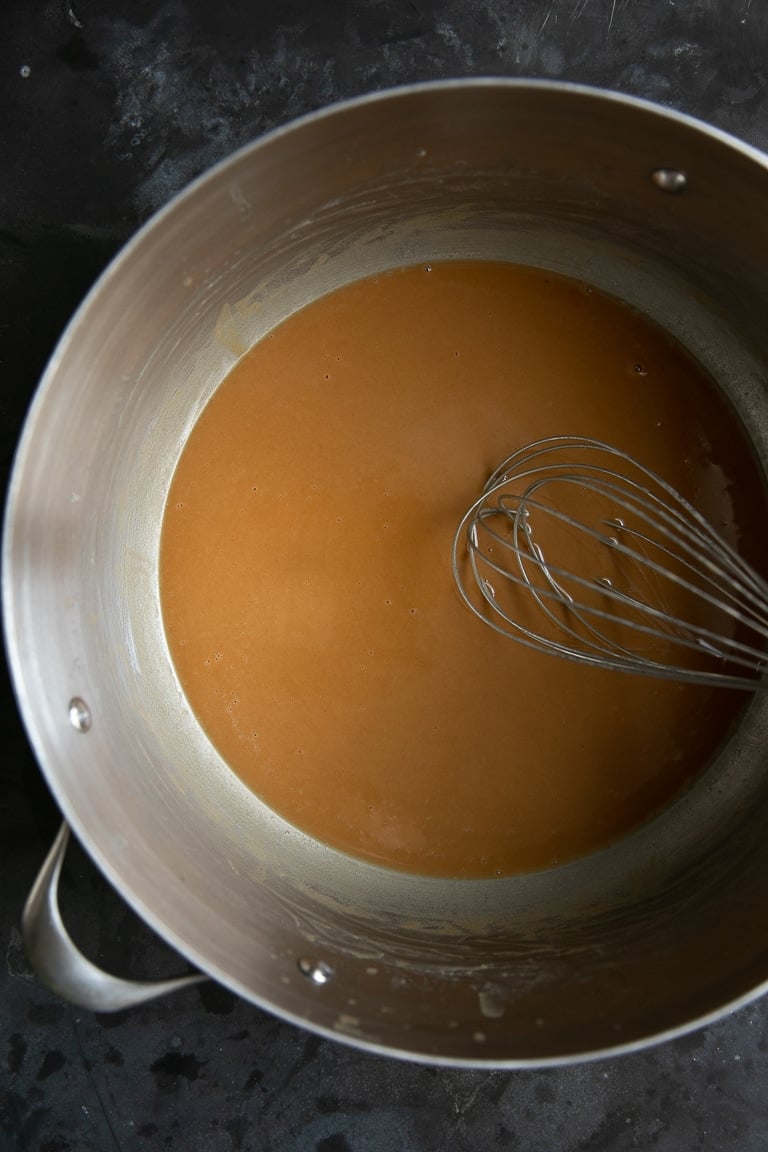
How to Make Gumbo
1. Make the roux (see above).
I do not recommend multi-tasking unless you’re super confident in the kitchen.
2. Sauté the smoked sausage.
Once the roux is finished, set it aside and pull out a large skillet. Quickly pan-fry the sausage over medium-high heat. If the sausage is already cooked, that’s ok. I still like to fry it up a bit as it adds a bit of extra flavor.
As the sausage cooks, toss the chicken in a bowl with olive oil, paprika, and some Cajun seasoning. Let the chicken rest until the sausage is finished cooking. Remove the sausage to a clean plate and set it aside.
3. Sear the chicken.
Add the chicken to the same skillet. Add additional olive oil if needed. Cook the chicken for about 2 minutes per side.
There is no need to fully cook the chicken as it will be added back to the Gumbo later to finish cooking. Remove the chicken to a clean plate and set aside (but keep the skillet as you’ll need that in just a sec!).
4. Boil the broth.
Get one more extra large pot (or transfer the roux to a clean bowl and set it aside so that you can clean and re-use the large pot that had been used previously).
Bring the chicken broth and bouillon cubes (if using) to a boil. Once boiling, cover and reduce to a simmer.
5. Cook the vegetables.
As the broth comes to a boil (yes, we’re multi-tasking now), grab the skillet that previously cooked the sausage and chicken to the stovetop and set over medium heat. Add one more tablespoon of oil and cook the Cajun trinity (onions, celery, and green peppers) for approximately 6-8 minutes, stirring frequently. Add the garlic and cook for an additional 30 seconds.
6. Begin putting things together.
Reduce heat to medium-low. Take the set-aside roux and combine it with the softened vegetables. Mix well to combine and cook, stirring continuously, for 1-2 minutes.
Now, remember the pot filled with simmering broth (step 4)? Take the roux and veggie mixture and slowly add it to the broth. Stir continuously until fully incorporated. Maintain a simmer.
7. Season and simmer.
Add the hot pepper sauce, bay leaves, 1 tablespoon of Cajun seasoning, dried thyme, diced tomatoes, and tomato sauce. Mix it up. Reduce heat to low and let your gumbo simmer for at least 45 minutes.
8. Sauté the okra.
As the gumbo simmers, cook the okra. Melt 2 tablespoons of butter in a large skillet over medium heat. Add the chopped okra and distilled white vinegar and sauté for approximately 10-15 minutes, stirring frequently (see image).
9. Finish putting everything together.
After approximately 45 minutes, add the cooked okra, chicken, and sausage to the pot. At the same time, add the Worcestershire sauce, crabmeat, and sea scallops. Simmer all together for an additional 20-30 minutes.
Season to taste.
Finally, 5-10 minutes before serving add the shrimp and stir in the filé powder. Continue to simmer until shrimp are fully cooked.
There you have it! I really have tried to make the instructions as easy to follow as possible.
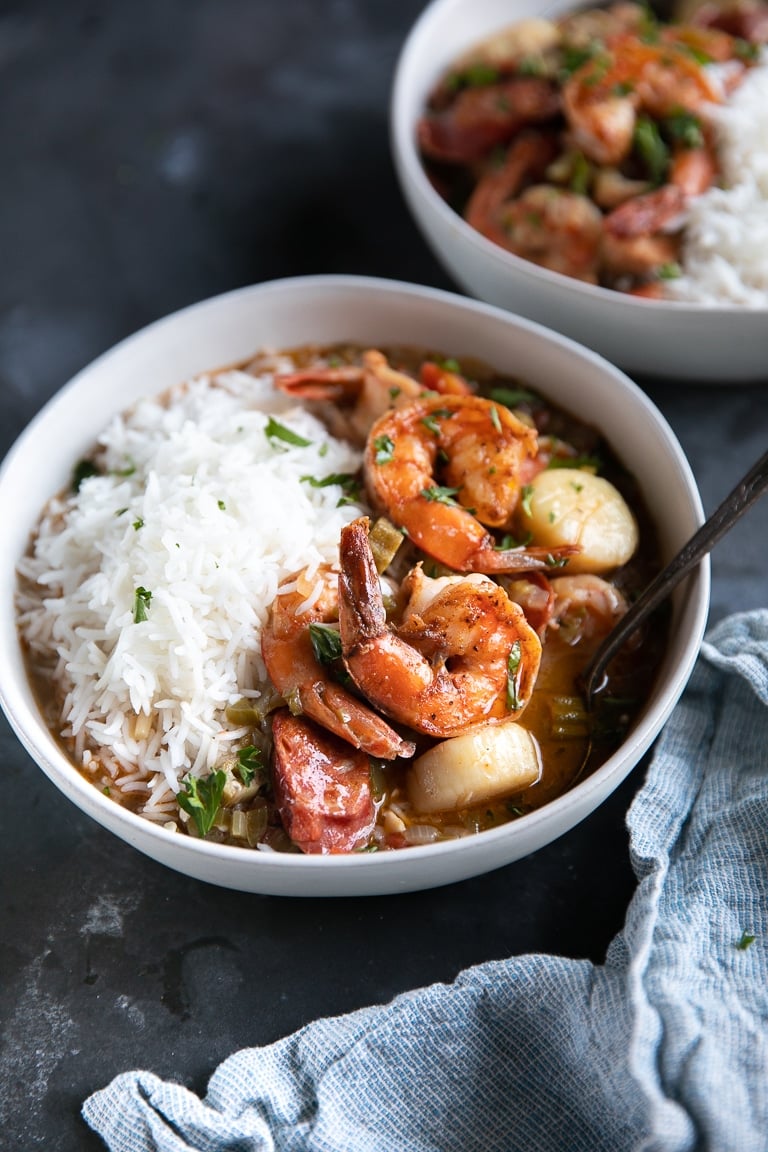
What to Serve with Gumbo?
Gumbo is traditionally served with a scoop of cooked white rice. The addition of rice helps feed a much larger number of people, making Gumbo both a practical and economical meal. Often, you will find Gumbo served with some kind of French bread, or, in some Cajun families, a side dish of potato salad.
Gumbo Thickeners
There are three main gumbo thickeners – the roux, filé powder, and okra.
- Roux: Preparing a good roux is key to making a good gumbo. As explained in full below, you’ll see the progression from light to dark roux. The lighter the roux, the less flavor it will have but the greater the thickening properties it will have. On the other hand, the darker the roux, the more flavorful it will be, but the less thickening power it will have.
- Filé Powder. Made from dried and ground sassafras leaves that grow natively in eastern North America. In general, it is recommended to add the Filé powder toward the end of the cooking process.
- Okra. Most popular in seafood gumbos, the seed pod of the okra plant is typically cooked first. You can use fresh or frozen okra, just be sure to thaw your frozen okra first before adding to the gumbo.
This recipe includes all three thickeners. However, if you cook your roux long enough, it will hopefully lose most of its thickening powers and just be there to flavor the stew.
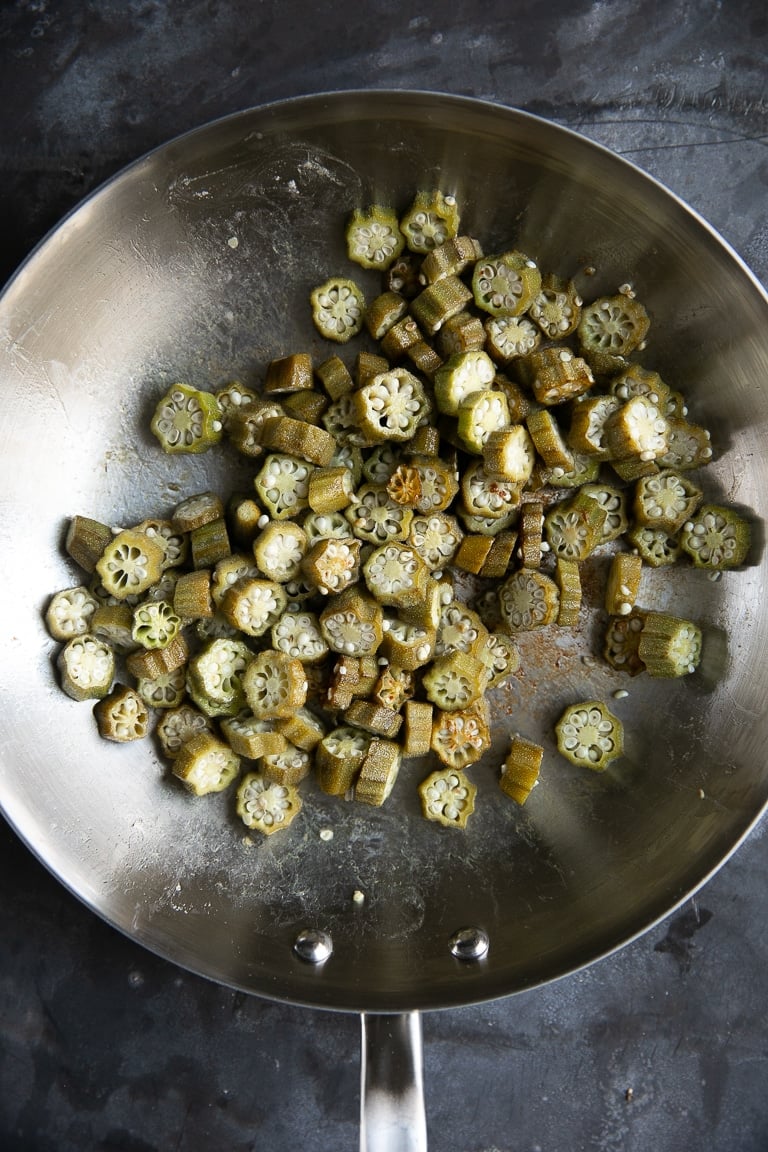
What’s the Difference Between Gumbo and Jambalaya?
The easiest way to remember the difference between the two is that Jambalaya is, at its core, a rice dish (like paella). It has protein, vegetables, sometimes tomatoes, rice, and stock that are simmered together to make one big happy pot of spicy rice.
Gumbo, on the other hand, is more of a soup. Like Jambalaya, Gumbo contains a mix of vegetables, sometimes meat, and always shellfish, but the overall stock is thinner. It starts with a roux, and unlike jambalaya, typically contains okra (or filé powder) with rice that is cooked separately, added just before serving.
Cajun vs. Creole Gumbo
Before Cajun cooking ever existed, there was Creole cooking. In other words, Creole cooking came first. Creole cooking dates back to the 1700s when New Orleans was founded by the French in 1718. Cajun cooking, on the other hand, didn’t come to Louisiana until the second half of the 18th century when Acadian exiles, later known as Cajuns, relocated outside of New Orleans.
In general, Cajun cuisine is viewed as less refined, more of a “country food”, since Acadian exiles didn’t have access to some of the luxuries that Creole people had thanks to trade. As such, Creole cuisine is often viewed as “city food”.
Main differences between Cajun and Creole Gumbo?
- Tomatoes: Creole cooking uses, or has access to, tomatoes, while Cajun cooking does not. This is because early Creole cooks had access to canned tomatoes from Sicily.
- The main source of fat: Creole cooking will often use butter as the primary source of fat, while Cajun cuisine will typically use vegetable oil or animal fat (or both).
- Seasoning: For the most part, Cajun and Creole seasoning are very similar. The primary difference, however, is that you will often find extra paprika in Creole cooking, in addition to sweet basil, celery seed, and white pepper.
- Meats: Typically, Creole gumbo will come filled with shellfish and some kind of ham or sausage – not chicken. Cajun gumbo, on the other hand, usually contains chicken and sausage.
This recipe is mostly a Creole Gumbo. Except where I’ve added chicken and made a roux using bacon drippings.
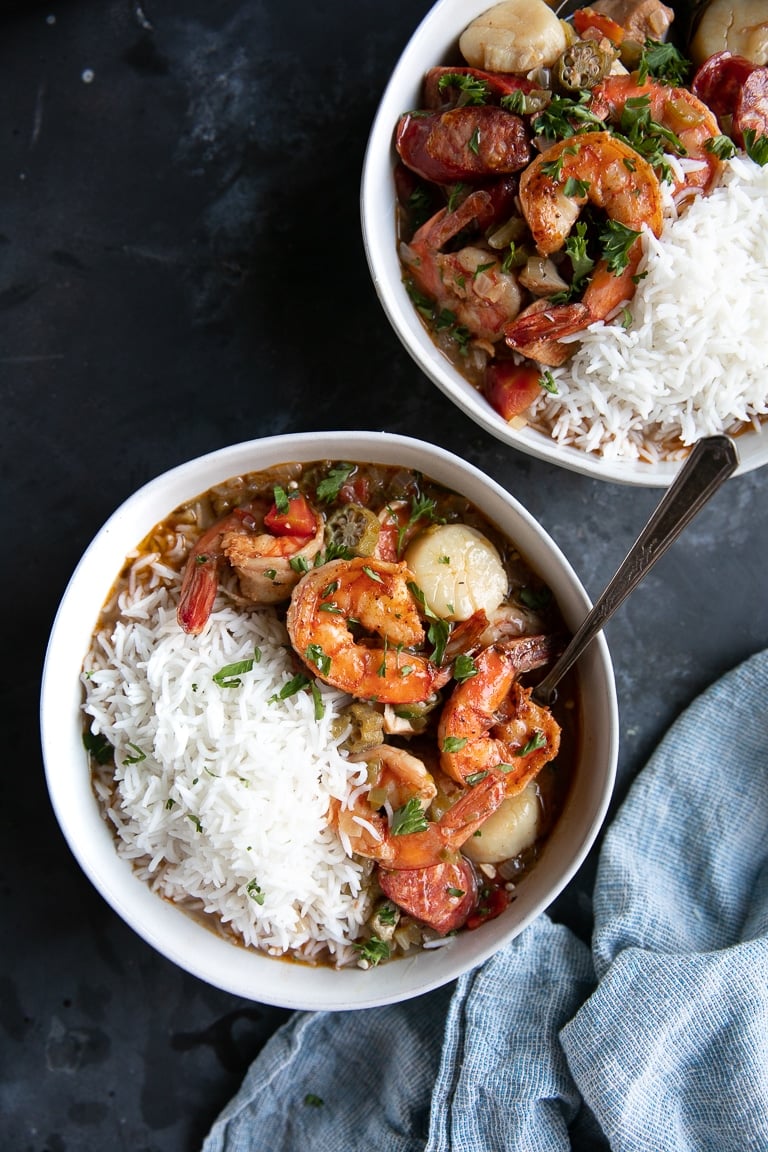
Frequently Asked Questions
Okra (or lady’s fingers as my mother-in-law calls them) is a type of vegetable, and how gumbo actually got its name (see above). Personally, I love okra. If you can’t find okra, or you know you dislike this oddly shaped vegetable, replace it with an additional teaspoon of filé powder at the end of cooking. Remember, if you’re using frozen okra, always thaw before adding.
Filé powder, made from dried and ground sassafras leaves, is a thickener often found in various gumbo recipes.
When being used as a thickener, you would typically replace the filé powder with okra. For every 1 tablespoon of filé powder, you’ll need about 2 cups of okra. You can also use cornstarch. Mix 2 teaspoons of cornstarch with 1 tablespoon of water to replace 1 tablespoon of filé powder.
Gumbo gets its flavor from several elements, but two ingredients are most important for both flavor and thickening: the roux and either okra or filé powder.
Andouille is a smoked sausage made from chopped pork, onions, wine, and seasoning. It has a smoky, sharp taste, and is sometimes spicy.
Substitute with a different variety of smoked sausage, Mexican chorizo, kielbasa, or skip the sausage completely.
Yes. The two are quite similar to each other so trading one for the other generally isn’t a big deal. The primary difference is that Creole seasoning typically contains additional paprika, sweet basil, celery seed, oregano, and white pepper.
Yes. This recipe is definitely on the spicier side. If you prefer a more mild dish, simply omit the added hot sauce. On the other hand, if you really love spicy foods, feel free to add a diced jalapeño at the same time as the holy trinity or garnish with hot sauce at the end of cooking.
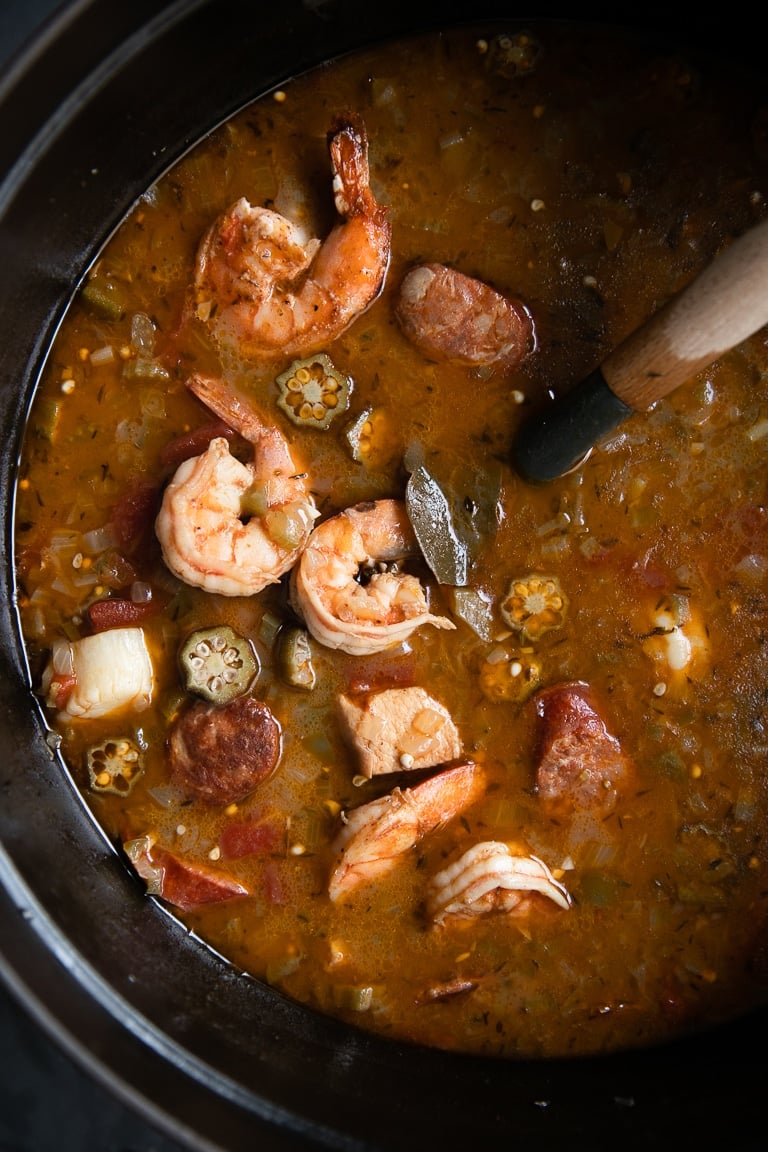
Can You Freeze Gumbo?
There are several ways to freeze Gumbo.
- Freeze just the roux in a sealed, air-tight container for up to 6 months.
- The broth, “Holy Trinity”, and roux combination in a sealed, air-tight container in the freezer for 3-6 months.
- Or, the whole thing, in a sealed, air-tight container in the freezer for 3-6 months.
If I had to pick one of these, I would pick option number 2. Most of the lengthy, time-consuming grunt work has been done already, but the meat (chicken, sausage, and especially seafood) hasn’t been added yet. Although chicken and sausage may freeze well, seafood does not.
More Cajun Recipes
Have you tried making this Gumbo Recipe? Tell me about it in the comments below! I always love to hear your thoughts. And tag me #theforkedspoon on Instagram if you’ve made any of my recipes, I always love to see what you’re cooking in the kitchen.

Gumbo Recipe
Ingredients
- 1 cup all-purpose flour
- ¾ cup bacon drippings or butter, or a mix of both
- 3 tbsp + 1 tsp oil, divided
- 2 teaspoon sweet paprika
- 2 tablespoon Cajun seasoning, divided
- 2 pounds chicken breast, chopped
- salt and black pepper, to season
- 1 pound smoked Andouille sausage, sliced
- 5 stalks celery, finely chopped
- 2 large onions, chopped
- 2 green bell peppers, seeded and finely chopped
- 5 cloves garlic, minced
- 3 quarts (12 cups) low-sodium chicken broth
- 3 cubes beef bullion , (optional)
- 1 tablespoon white sugar
- 1 teaspoon salt, plus more to taste
- 3 tablespoon hot pepper sauce, (I used Tabasco sauce)
- 4 bay leaves
- ½ teaspoon dried thyme
- 1 (14.5 ounce) can diced tomatoes
- 1 cup tomato sauce
- 2 tablespoon butter
- 1 pound okra, chopped
- 2 tablespoon distilled white vinegar
- 2 tablespoon Worcestershire sauce
- 1 pound lump crabmeat
- 2 pounds jumbo sea scallops
- 2 pounds raw, uncooked, shrimp, peeled and deveined
- 4 teaspoon gumbo filé powder
- Fresh chopped parsley
Instructions
- Make the roux. Add the bacon drippings (or a mix of bacon drippings plus butter or just butter) to a large, heavy-bottomed saucepan set over medium-low heat. Add the flour, whisking continuously to create a smooth mixture. Continue to cook, stirring continuously, for 1-2 hours. The color will turn from a creamy off-white to a light caramel, to a darker mahogany brown color (see notes). Take care and watch the heat level as you do not want to burn the roux (otherwise you will need to start over). Once the roux has reached the desired doneness, remove it from heat and set it aside.
- Add 1 tablespoon of olive oil, paprika, 1 teaspoon Cajun seasoning, and chopped chicken to a medium-size mixing bowl. Mix well to coat the chicken in the spices. Set aside.
- Add 1 tablespoon olive oil to a large skillet or Dutch oven. Swirl to coat the surface of the skillet. Add the smoked sausage in a single layer and brown on each side for 1-2 minutes. Remove the sausage from the pan to a clean plate and set it aside.
- In the same skillet add one tsp olive oil. Add the chicken and cook for approximately 2 minutes on each side (it’s ok if the chicken isn’t fully cooked). Remove from the pan to a clean plate and set aside.
- Add the low-sodium chicken broth to a large pot over high heat. Bring to a boil and stir in 3 beef bouillon packets and 1 tablespoon white sugar.
- Meanwhile, as the broth comes to a boil, add the final tablespoon of olive oil to the same skillet as the chicken and sausage over medium heat. Add the celery and onion and sprinkle with salt and pepper to season. Sauté for 4-5 minutes, stirring often. Stir in the green bell peppers and continue to cook for an additional 3-4 minutes. Finally, add the garlic and sauté until fragrant, approximately 30 seconds.
- Reduce heat to medium-low and transfer the roux to the same skillet as the onion and celery mixture. Mix well and stir continuously for 1-2 minutes.
- Slowly whisk the vegetable and roux mixture into the pot of boiling chicken broth. Reduce heat to a simmer and add the hot pepper sauce, bay leaves, 1 tablespoon Cajun seasoning, dried thyme, diced tomatoes, and tomato sauce. Mix well to combine.
- Reduce heat to low and simmer for 45 minutes. After 45 minutes add the chicken and sausage to the pot. Continue to simmer for an additional 15 minutes.
- As the gumbo simmers, melt 2 tablespoons of butter in a large skillet over medium heat. Add the chopped okra and distilled white vinegar and sauté for approximately 10-15 minutes, stirring frequently. Remove from heat and add to the Gumbo.
- Add the Worcestershire sauce, crabmeat, and sea scallops to the pot and continue to simmer for an additional 20-30 minutes.
- 10 minutes before serving, stir in the gumbo filé powder and shrimp. Simmer until shrimp are fully cooked.
- Traditionally served with rice and fresh chopped parsley. Enjoy!
Notes
- You will need at least 3 hours to prepare and cook this recipe.
- You will need a large pot or Dutch oven, at least 8-10 quarts.
- Note that my roux could have been darker, but I ran out of time as it was nearly dark outside and I still needed to get photos taken.
- This recipe is relatively spicy, please adjust with more or less hot sauce and spices to taste.
Nutrition
Nutrition information is automatically calculated, so should only be used as an approximation.
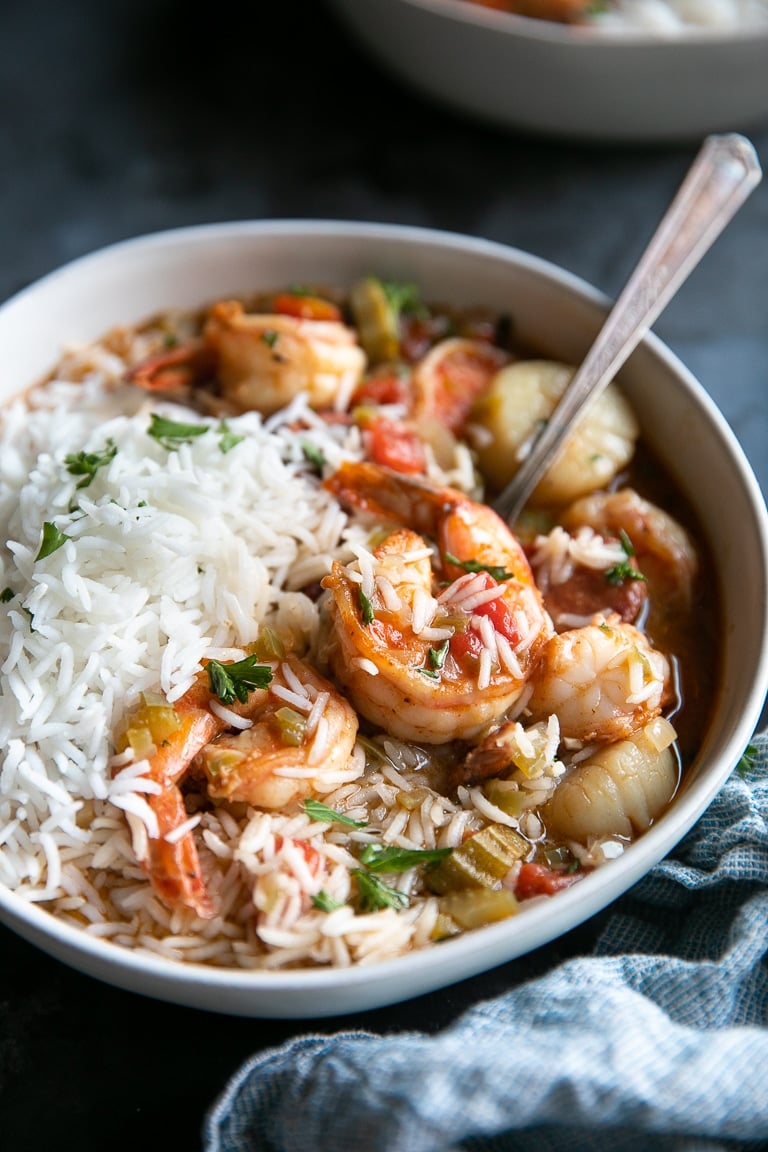





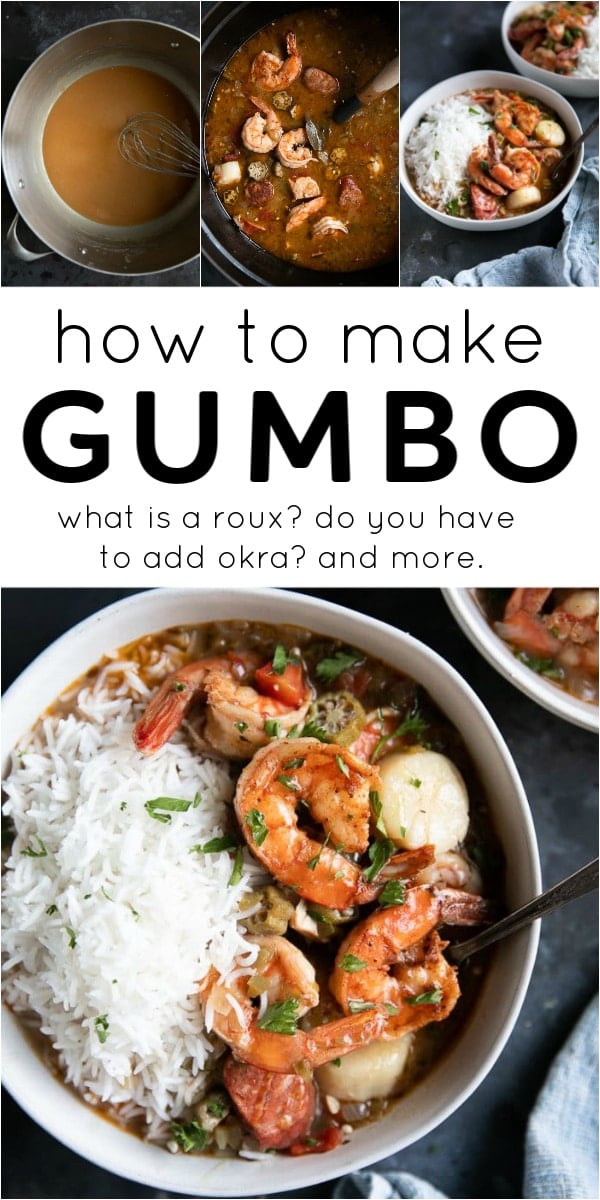

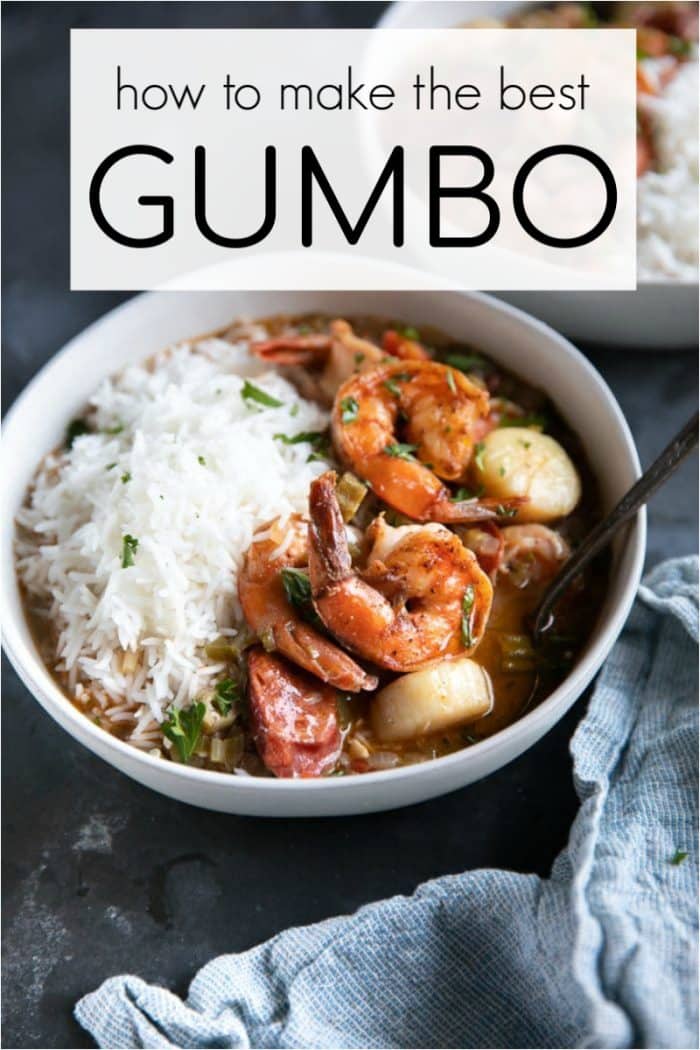


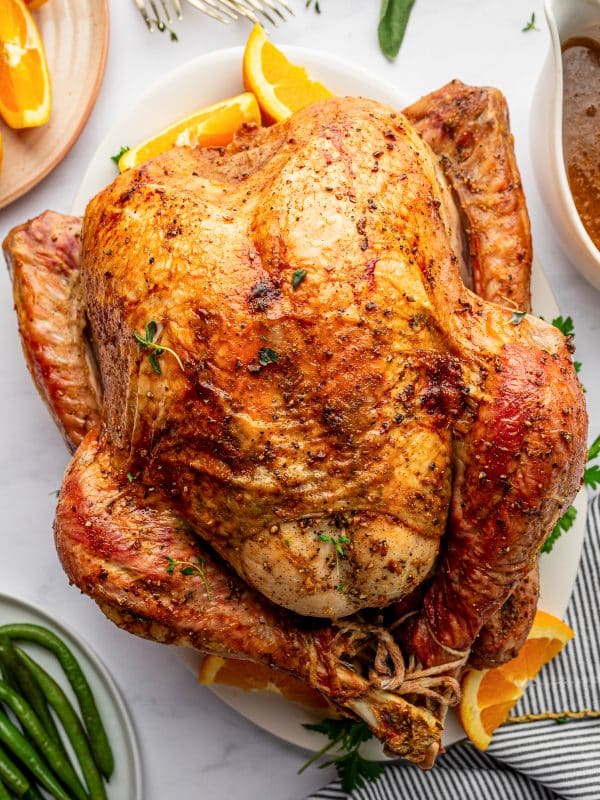
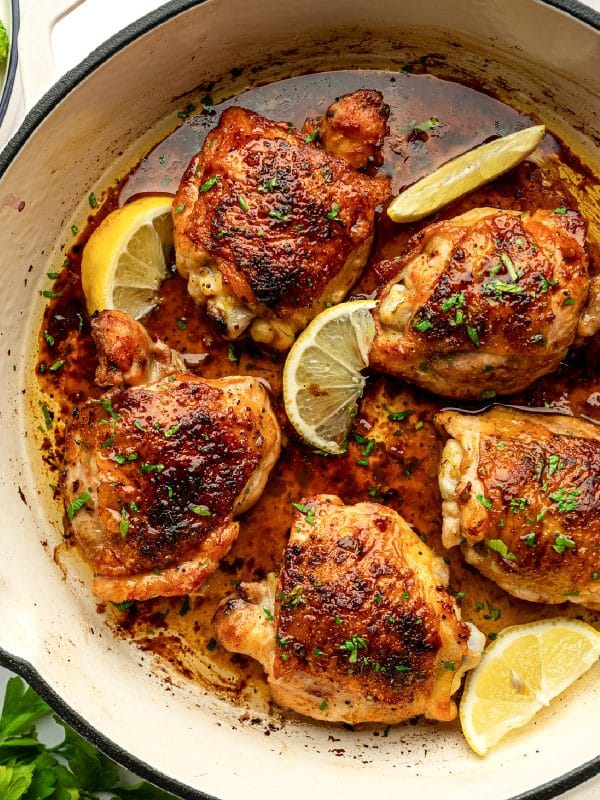
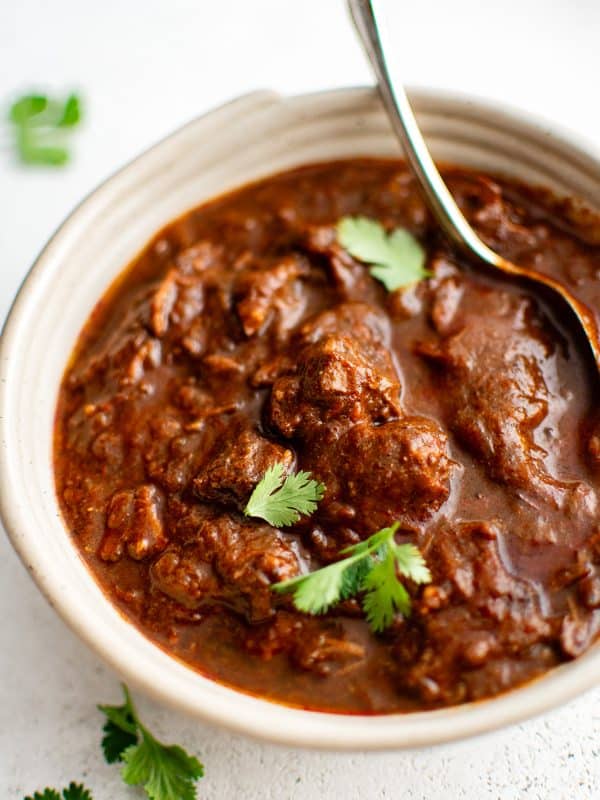
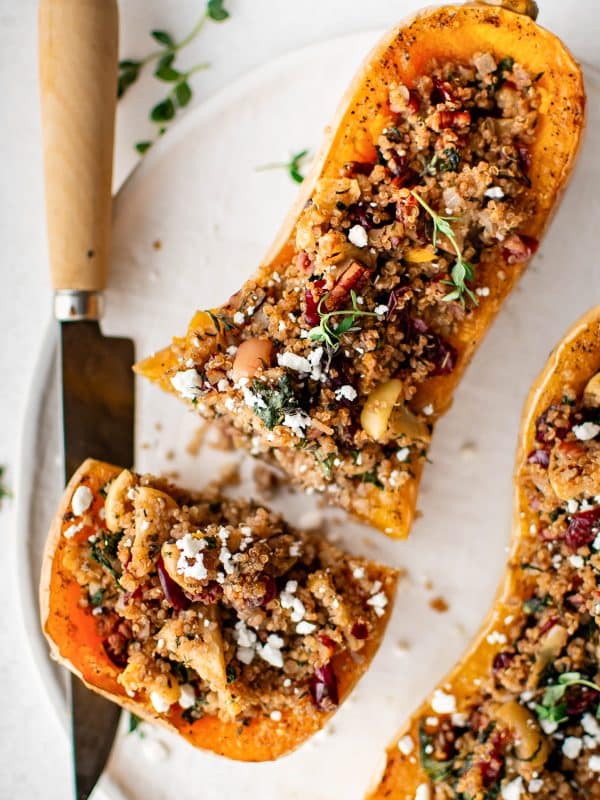








Same as Liz, been bringing this to Thanksgiving for years now. My brother in-law that hosts insists on it, and it gets rave reviews (though we still have turkey too). Generally make it at 2x and it comes out great. Also use the bay scallops and omit the crab to keep the budget down. Did sea scallops one year and ended up cutting them in half anyway to make them spoonable. Going to try a gluten-free roux this year to make it accessible for the gluten free folks.
I love that this has become a non-negotiable on your Thanksgiving table, that makes me so happy! 🙂
Thank you for sharing all your tweaks too; doubling it, using bay scallops, and trying a gluten-free roux are such smart ways to keep it budget-friendly and accessible while still totally indulgent.
Absolutely Fantastic Gumbo. I started making this recipe in 2019. Now we make 2 times a year. It has even replaced the Turkey Dinner at Thanksgiving.
I omit the crab- noticed it was lost in the robust flavor. I also use Bay Scallops for smaller bites of Scallops. Takes me about 3 hours and I get rave reviews Everytime.
I really appreciate that comment Liz, it really made my day 🙂
A quick correction to step 5 (which you probably know, but mistyped). Mirepoix is onions, carrots, and celery. Cajun trinity is peppers, onions, and celery. You said mirepoix instead of trinity.
Thanks Nick, I updated that typo 🙂